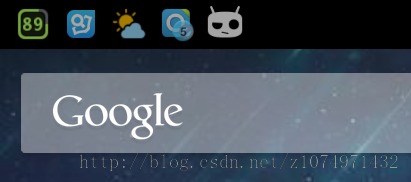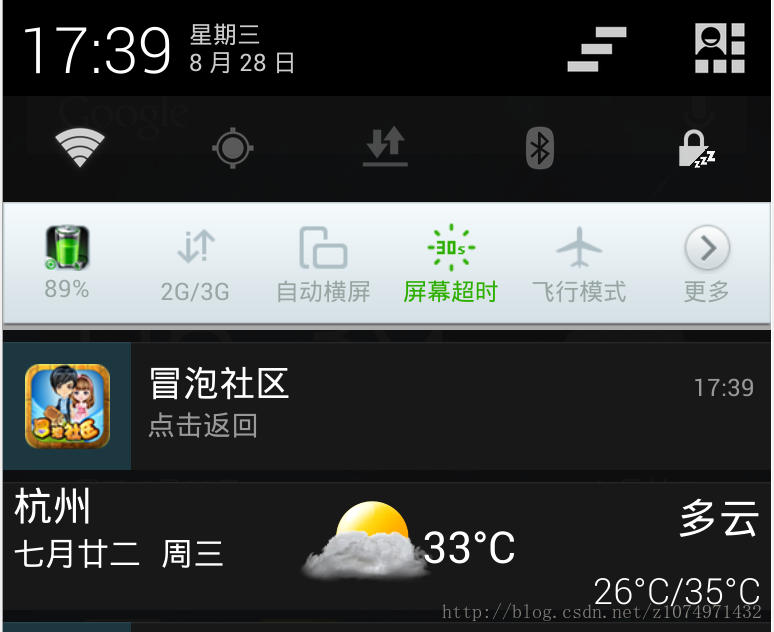本文實例講述了android不使用自定義布局情況下實現(xiàn)自定義通知欄圖標的方法。分享給大家供大家參考,具體如下:
自定義通知欄圖標?不是很簡單么。自定義布局都不在話下!
是的,有xml布局文件當然一切都很簡單,如果不給你布局文件用呢?
聽我慢慢道來!
首先怎么創(chuàng)建一個通知呢?
1.new 一個
參數(shù):圖標 id,發(fā)送到狀態(tài)欄瞬間的文字,當前時間
2.設置詳細信息:標題、內(nèi)容、intent
|
1
2
|
pendingintent contentintent = pendingintent.getbroadcast(this, 0, intent, pendingintent.flag_update_current);n.setlatesteventinfo(this, "早上好!", "今天是個晴朗的天氣!", contentintent); |
3.發(fā)送到通知欄
|
1
2
|
notificationmanager mnm = (notificationmanager) getsystemservice(context.notification_service);mnm.notify(1001, n); |
這樣就完成了一個通知的展示,很簡單!
我們來看看 n.setlatesteventinfo 干了些什么呢
|
1
2
3
4
5
6
7
8
9
10
11
12
13
14
15
16
17
18
19
20
21
22
23
24
25
26
27
28
29
30
31
|
public void setlatesteventinfo(context context, charsequence contenttitle, charsequence contenttext, pendingintent contentintent) { // todo: rewrite this to use builder remoteviews contentview = new remoteviews(context.getpackagename(), r.layout.notification_template_base); if (this.icon != 0) { contentview.setimageviewresource(r.id.icon, this.icon); } if (priority < priority_low) { contentview.setint(r.id.icon, "setbackgroundresource", r.drawable.notification_template_icon_low_bg); contentview.setint(r.id.status_bar_latest_event_content, "setbackgroundresource", r.drawable.notification_bg_low); } if (contenttitle != null) { contentview.settextviewtext(r.id.title, contenttitle); } if (contenttext != null) { contentview.settextviewtext(r.id.text, contenttext); } if (this.when != 0) { contentview.setviewvisibility(r.id.time, view.visible); contentview.setlong(r.id.time, "settime", when); } if (this.number != 0) { numberformat f = numberformat.getintegerinstance(); contentview.settextviewtext(r.id.info, f.format(this.number)); } this.contentview = contentview; this.contentintent = contentintent;} |
可以看到,他實際上就是使用系統(tǒng)默認布局為我們創(chuàng)建了一個 remoteviews ,remoteviews 是專門用來跨進程顯示的 view ,詳情參考官方文檔:http://developer.android.com/intl/zh-cn/reference/android/widget/remoteviews.html
看這句:
其實就是設置圖標了:
參數(shù)1:用來顯示圖標的 imageview 的 id
參數(shù)2:圖標 id
但是還有一個這樣的方法:
用 bitmap 來設置圖標。
而 notifycation 里面有個參數(shù):notification.contentview,仔細看,setlastesteventinfo 方法里創(chuàng)建的 remoteviews 就是他,所以你知道該怎么做了!
但是這里還有一個問題?r.id.icon 怎么獲取,這個東西其實在 com.android.internal.r 這個里面,但是這個類我們訪問不到怎么辦?
反射唄, java 的反射可謂是萬能啊,啥都可以拿到只要他在。
|
1
2
3
4
|
class<?> clazz = class.forname("com.android.internal.r$id"); field field = clazz.getfield("icon"); field.setaccessible(true); int id_icon = field.getint(null); |
|
1
2
3
4
5
|
n.setlatesteventinfo(context, title, msg, contentintent);n.flags |= notification.flag_auto_cancel;if(n.contentview != null && icon != null){ n.contentview.setimageviewbitmap(id_icon, icon);} |
發(fā)出通知,下拉通知欄看看,圖標是不是變了^_^
此外這里還有一個小細節(jié),就是你 new notifycation() 是傳進去的圖標會作為狀態(tài)欄的小圖標,小圖標尺寸在 hdpi 下面放 32x32 的就可以

所以你可以第一次傳小圖標,然后通過 contentview 設置大圖標,這樣就ok了

希望本文所述對大家android程序設計有所幫助。














